Mounted Absorptive Neutral Density Filters
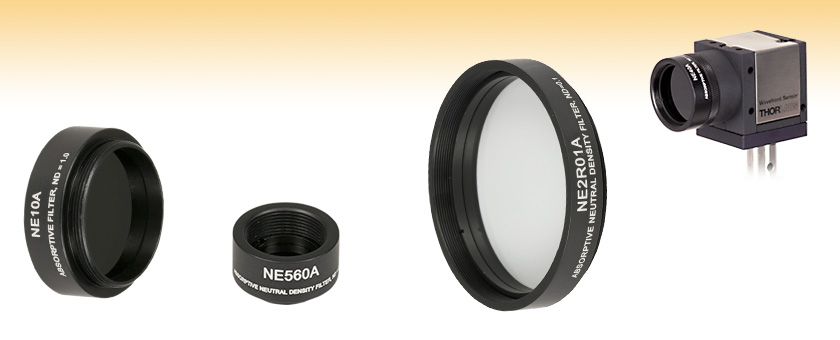
- Optical Densities from 0.1 to 8.0
- Attenuate Visible Light
- Ø1/2", Ø25 mm, and Ø2" Filters Available
- Mounts Engraved with Optical Density
NE10A
Ø25 mm Filter,
SM1-Threaded Mount
NE560A
Ø1/2" Filter,
SM05-Threaded Mount
NE2R01A
Ø2" Filter,
SM2-Threaded Mount
NE04A, SM1A9 Adapter,
and Shack-Hartmann
Wavefront Sensor

Please Wait
| Table 1.1 Neutral Density Filter Selection Guide |
|
|---|---|
| Absorptive | |
| Uncoated (400 - 650 nm) |
Mounted |
| Unmounted | |
| Uncoated (1000 - 2600 nm) |
Mounted |
| Unmounted | |
| AR Coated (350 - 700 nm) |
Mounted |
| Unmounted | |
| AR Coated (650 - 1050 nm) |
Mounted |
| Unmounted | |
| AR Coated (1050 - 1700 nm) |
Mounted |
| Unmounted | |
| Variable | |
| Reflective | |
| UV Fused Silica (200 - 1200 nm) |
Mounted |
| Unmounted | |
| N-BK7 (350 - 1100 nm) |
Mounted |
| Unmounted | |
| ZnSe (2 - 16 µm) |
Mounted |
| Unmounted | |
| Wedged UVFS (200 - 1200 nm) | |
| Wedged N-BK7 (350 - 1100 nm) | |
| Wedged ZnSe (2 - 16 µm) | |
| Variable | |
| Neutral Density Filter Kits | |
Features
- Three Sizes Available:
- Ø1/2" Filter in an SM05-Threaded Mount
- Ø25 mm Filter in an SM1-Threaded Mount
- Ø2" Filter in an SM2-Threaded Mount
- Optical Densities Ranging from 0.1 to 8.0
- Ideal for Low-Power Applications (<1 W, See the Specs Tab for Additional Details)
- Mount Engraved with Part Number and Optical Density
- Absorptive Glass Reduces Multiple Reflections
Thorlabs' Mounted Absorptive Neutral Density (ND) Filters are available with optical densities (OD) ranging from 0.1 to 8.0. They are offered in diameters of 1/2", 25 mm, and 2", which come mounted in SM05- (0.535"-40), SM1- (1.035"-40), or SM2-threaded (2.035"-40) lens tubes, respectively. These housings are engraved with both the part number and optical density for easy identification and are directly compatible with a wide range of rigid construction optomechanical parts such as our cage systems and lens tubes accessories. Filters are sold individually as well as in filter kits. Empty cases with foam inserts for storing loose mounted filters are also available for purchase below.
Unlike their reflective, metallic counterparts, each absorptive ND filter is fabricated from a Schott glass substrate that has been selected for its spectrally flat absorption coefficient in the visible region of 400 - 650 nm. By varying the type and thickness of the glass used, we are able to produce the entire line of absorptive ND filters from just four types of Schott glass. Because of variations between different lots of glass, Thorlabs recommends that the user calibrate the filter in their setup before taking quantitative measurements. The Specs tab contains the nominal transmission and damage threshold of each filter type, while the Graphs tab contains transmission and reflectivity curves for the 300 - 1100 nm wavelength range.
If desired, a mounted filter can be removed from its housing by unscrewing the retaining ring that secures the filter to the mount. Thorlabs offers a range of spanner wrenches that are an ideal match to these retaining rings. The round filters listed on this page are also sold unmounted. The equivalent unmounted filter is listed in the drawing for each mounted filter, accessible through the red docs icons (![]() ) below.
) below.
The filters sold on this page are uncoated. For our full selection of coated and uncoated ND filters, please see Table 1.1.
Optical Density and Transmission
Optical density (OD) indicates the attenuation factor provided by an optical filter, i.e. how much it reduces the optical power of an incident beam. OD is related to the transmission, T, by the equation

where T is a value between 0 and 1. Choosing an ND filter with a higher optical density will translate to lower transmission and greater absorption of the incident light. For higher transmission and less absorption, a lower optical density would be appropriate. As an example, if a filter with an OD of 2 results in a transmission value of 0.01, this means the filter attenuates the beam to 1% of the incident power. Please note that the transmission data for our neutral density filters is provided in percent (%).
Please note that these products are not designed for use as laser safety equipment. For lab safety, Thorlabs offers an extensive line of safety and blackout products, including beam blocks, that significantly reduce exposure to stray light.
| Filter Sizes | Ø1/2" | Ø25 mm | Ø2" |
|---|---|---|---|
| Diameter Tolerance | +0.0 / -0.25 mm | ||
| Clear Aperture | >Ø11.0 mm | >Ø20.0 mm | >Ø45.7 mm |
| Surface Quality | 40-20 Scratch-Dig | ||
| Substrate | NG1, NG4, NG9, or NG11 (Schott Glass) | ||
| For OD < 1.3: | |||
| Transmitted Wavefront Error (TWE) | <λ/4 (@ 633 nm) | <λ/4 (@ 633 nm) | <λ/4 (@ 633 nm) |
| For OD ≥ 1.3: | |||
| Surface Flatness | <λ/2 (@ 633 nm) | - | <2λ (@ 633 nm) |
| Transmitted Wavefront Error (TWE) | - | <λ/4 (@ 633 nm) | - |
| Damage Threshold Specifications | ||
|---|---|---|
| Optical Density | Damage Threshold | |
| 0.2 | Pulsed | 10 J/cm2 (532 nm, 10 ns, 10 Hz, Ø0.456 mm) |
| 0.3 | CWa | 25 W/cm (532 nm, Ø1.0 mm) |
| 1.0 | CWa | 12 W/cm (532 nm, Ø1.0 mm) |
| Pulsed | 10 J/cm2 (532 nm, 10 ns, 10 Hz, Ø0.504 mm) | |
| 2.0 | CWa,b | 12 W/cm (532 nm, Ø1.0 mm) |
| Pulsed | 10 J/cm2 (532 nm, 10 ns, 10 Hz, Ø0.390 mm) | |
| 4.0 | CWa | 10 W/cm (532 nm, Ø1.0 mm) |
| Pulsed | 5 J/cm2 (532 nm, 10 ns, 10 Hz, Ø0.340 mm) | |
| 6.0 | Pulsed | 5 J/cm2 (532 nm, 10 ns, 10 Hz, Ø0.340 mm) |
| Optical Density (@ 633 nm) |
Theoretical Transmissiona (@ 633 nm) |
Substrate Thicknessb | Substrate |
|---|---|---|---|
| 0.1 ± 0.01 | 77.6 to 81.3% | 0.6 mm | NG11 |
| 0.2 ± 0.01 | 61.7 to 64.6% | 1.4 mm | NG11 |
| 0.3 ± 0.015 | 50% | 2.3 mm | NG11 |
| 0.4 ± 0.02 | 40% | 0.7 mm | NG4 |
| 0.5 ± 0.025 | 32% | 0.9 mm | NG4 |
| 0.6 ± 0.03 | 25% | 1.1 mm | NG4 |
| 0.7 ± 0.035 | 20% | 1.3 mm | NG4 |
| 0.8 ± 0.04 | 16% | 1.5 mm | NG4 |
| 0.9 ± 0.045 | 13% | 1.7 mm | NG4 |
| 1.0 ± 0.05 | 10% | 1.9 mm | NG4 |
| 1.3 ± 0.065 | 5% | 2.5 mm | NG4 |
| 1.5 ± 0.075 | 3% | 2.9 mm | NG4 |
| 2.0 ± 0.10 | 1% | 1.4 mm | NG9 |
| 3.0 ± 0.15 | 0.1% | 2.1 mm | NG9 |
| 4.0 ± 0.20 | 1.0x10-2% | 2.8 mm | NG9 |
| 5.0 ± 0.25 | 1.0x10-3% | 3.6 mm | NG9 |
| 6.0 ± 0.30 | 1.0x10-4% | 1.5 mm | NG1 |
| 7.0 ± 0.35 | 1.0x10-5% | 1.7 mm | NG1 |
| 8.0 ± 0.40 | 1.0x10-6% | 1.9 mm | NG1 |
Optical Density
Optical density (OD) indicates the attenuation factor provided by an optical filter, i.e. how much it reduces the optical power of an incident beam. OD is related to the transmission, T, by the equation

where T is a value between 0 and 1. Choosing an ND filter with a higher optical density will translate to lower transmission and greater absorption of the incident light. For higher transmission and less absorption, a lower optical density would be appropriate. As an example, if a filter with an OD of 2 results in a transmission value of 0.01, this means the filter attenuates the beam to 1% of the incident power. Please note that the transmission data for our neutral density filters is provided in percent (%).
| For Detailed Plot Information | |
|---|---|
| Please use the icon shown to the left in the product listings for plots of the wavelength-dependent transmission (and optical density) for each filter type. Excel files containing the raw data used to make these plots are also available for download. | |
| Optical Density | Transmission Raw Data files are available for each part by clicking on the blue "info icons" in the tables in the pricing area. |
Reflectance An Excel file with 8° AOI reflectance data is also available. |
|---|---|---|
| OD 0.1 - 0.5 | ||
| OD 0.6 - 0.9 | ||
| OD 1.0 - 2.0 | ||
| OD 3.0 - 4.0 | ||
| OD 5.0 - 6.0 | ||
| OD 7.0 - 8.0 |
| Table 4.1 Damage Threshold Specifications | ||
|---|---|---|
| Optical Density | Damage Threshold | |
| 0.2 | Pulsed | 10 J/cm2 (532 nm, 10 ns, 10 Hz, Ø0.456 mm) |
| 0.3 | CWa | 25 W/cm (532 nm, Ø1.0 mm) |
| 1.0 | CWa | 12 W/cm (532 nm, Ø1.0 mm) |
| Pulsed | 10 J/cm2 (532 nm, 10 ns, 10 Hz, Ø0.504 mm) | |
| 2.0 | CWa,b | 12 W/cm (532 nm, Ø1.0 mm) |
| Pulsed | 10 J/cm2 (532 nm, 10 ns, 10 Hz, Ø0.390 mm) | |
| 4.0 | CWa | 10 W/cm (532 nm, Ø1.0 mm) |
| Pulsed | 5 J/cm2 (532 nm, 10 ns, 10 Hz, Ø0.340 mm) | |
| 6.0 | Pulsed | 5 J/cm2 (532 nm, 10 ns, 10 Hz, Ø0.340 mm) |
Damage Threshold Data for Thorlabs' Absorptive ND Filters
The specifications in Table 4.1 are measured data for Thorlabs' absorptive neutral density filters. Damage threshold specifications are constant for a given optical density, regardless of the size of the filter.
Laser Induced Damage Threshold Tutorial
The following is a general overview of how laser induced damage thresholds are measured and how the values may be utilized in determining the appropriateness of an optic for a given application. When choosing optics, it is important to understand the Laser Induced Damage Threshold (LIDT) of the optics being used. The LIDT for an optic greatly depends on the type of laser you are using. Continuous wave (CW) lasers typically cause damage from thermal effects (absorption either in the coating or in the substrate). Pulsed lasers, on the other hand, often strip electrons from the lattice structure of an optic before causing thermal damage. Note that the guideline presented here assumes room temperature operation and optics in new condition (i.e., within scratch-dig spec, surface free of contamination, etc.). Because dust or other particles on the surface of an optic can cause damage at lower thresholds, we recommend keeping surfaces clean and free of debris. For more information on cleaning optics, please see our Optics Cleaning tutorial.
Testing Method
Thorlabs' LIDT testing is done in compliance with ISO/DIS 11254 and ISO 21254 specifications.
First, a low-power/energy beam is directed to the optic under test. The optic is exposed in 10 locations to this laser beam for 30 seconds (CW) or for a number of pulses (pulse repetition frequency specified). After exposure, the optic is examined by a microscope (~100X magnification) for any visible damage. The number of locations that are damaged at a particular power/energy level is recorded. Next, the power/energy is either increased or decreased and the optic is exposed at 10 new locations. This process is repeated until damage is observed. The damage threshold is then assigned to be the highest power/energy that the optic can withstand without causing damage. A histogram such as that shown in Figure 37B represents the testing of one BB1-E02 mirror.

Figure 37A This photograph shows a protected aluminum-coated mirror after LIDT testing. In this particular test, it handled 0.43 J/cm2 (1064 nm, 10 ns pulse, 10 Hz, Ø1.000 mm) before damage.

Figure 37B Example Exposure Histogram used to Determine the LIDT of
| Table 37C Example Test Data | |||
|---|---|---|---|
| Fluence | # of Tested Locations | Locations with Damage | Locations Without Damage |
| 1.50 J/cm2 | 10 | 0 | 10 |
| 1.75 J/cm2 | 10 | 0 | 10 |
| 2.00 J/cm2 | 10 | 0 | 10 |
| 2.25 J/cm2 | 10 | 1 | 9 |
| 3.00 J/cm2 | 10 | 1 | 9 |
| 5.00 J/cm2 | 10 | 9 | 1 |
According to the test, the damage threshold of the mirror was 2.00 J/cm2 (532 nm, 10 ns pulse, 10 Hz, Ø0.803 mm). Please keep in mind that these tests are performed on clean optics, as dirt and contamination can significantly lower the damage threshold of a component. While the test results are only representative of one coating run, Thorlabs specifies damage threshold values that account for coating variances.
Continuous Wave and Long-Pulse Lasers
When an optic is damaged by a continuous wave (CW) laser, it is usually due to the melting of the surface as a result of absorbing the laser's energy or damage to the optical coating (antireflection) [1]. Pulsed lasers with pulse lengths longer than 1 µs can be treated as CW lasers for LIDT discussions.
When pulse lengths are between 1 ns and 1 µs, laser-induced damage can occur either because of absorption or a dielectric breakdown (therefore, a user must check both CW and pulsed LIDT). Absorption is either due to an intrinsic property of the optic or due to surface irregularities; thus LIDT values are only valid for optics meeting or exceeding the surface quality specifications given by a manufacturer. While many optics can handle high power CW lasers, cemented (e.g., achromatic doublets) or highly absorptive (e.g., ND filters) optics tend to have lower CW damage thresholds. These lower thresholds are due to absorption or scattering in the cement or metal coating.

Figure 37D LIDT in linear power density vs. pulse length and spot size. For long pulses to CW, linear power density becomes a constant with spot size. This graph was obtained from [1].

Figure 37E Intensity Distribution of Uniform and Gaussian Beam Profiles
Pulsed lasers with high pulse repetition frequencies (PRF) may behave similarly to CW beams. Unfortunately, this is highly dependent on factors such as absorption and thermal diffusivity, so there is no reliable method for determining when a high PRF laser will damage an optic due to thermal effects. For beams with a high PRF both the average and peak powers must be compared to the equivalent CW power. Additionally, for highly transparent materials, there is little to no drop in the LIDT with increasing PRF.
In order to use the specified CW damage threshold of an optic, it is necessary to know the following:
- Wavelength of your laser
- Beam diameter of your beam (1/e2)
- Approximate intensity profile of your beam (e.g., Gaussian)
- Linear power density of your beam (total power divided by 1/e2 beam diameter)
Thorlabs expresses LIDT for CW lasers as a linear power density measured in W/cm. In this regime, the LIDT given as a linear power density can be applied to any beam diameter; one does not need to compute an adjusted LIDT to adjust for changes in spot size, as demonstrated in Figure 37D. Average linear power density can be calculated using this equation.

This calculation assumes a uniform beam intensity profile. You must now consider hotspots in the beam or other non-uniform intensity profiles and roughly calculate a maximum power density. For reference, a Gaussian beam typically has a maximum power density that is twice that of the uniform beam (see Figure 37E).
Now compare the maximum power density to that which is specified as the LIDT for the optic. If the optic was tested at a wavelength other than your operating wavelength, the damage threshold must be scaled appropriately. A good rule of thumb is that the damage threshold has a linear relationship with wavelength such that as you move to shorter wavelengths, the damage threshold decreases (i.e., a LIDT of 10 W/cm at 1310 nm scales to 5 W/cm at 655 nm):

While this rule of thumb provides a general trend, it is not a quantitative analysis of LIDT vs wavelength. In CW applications, for instance, damage scales more strongly with absorption in the coating and substrate, which does not necessarily scale well with wavelength. While the above procedure provides a good rule of thumb for LIDT values, please contact Tech Support if your wavelength is different from the specified LIDT wavelength. If your power density is less than the adjusted LIDT of the optic, then the optic should work for your application.
Please note that we have a buffer built in between the specified damage thresholds online and the tests which we have done, which accommodates variation between batches. Upon request, we can provide individual test information and a testing certificate. The damage analysis will be carried out on a similar optic (customer's optic will not be damaged). Testing may result in additional costs or lead times. Contact Tech Support for more information.
Pulsed Lasers
As previously stated, pulsed lasers typically induce a different type of damage to the optic than CW lasers. Pulsed lasers often do not heat the optic enough to damage it; instead, pulsed lasers produce strong electric fields capable of inducing dielectric breakdown in the material. Unfortunately, it can be very difficult to compare the LIDT specification of an optic to your laser. There are multiple regimes in which a pulsed laser can damage an optic and this is based on the laser's pulse length. The highlighted columns in Table 37F outline the relevant pulse lengths for our specified LIDT values.
Pulses shorter than 10-9 s cannot be compared to our specified LIDT values with much reliability. In this ultra-short-pulse regime various mechanics, such as multiphoton-avalanche ionization, take over as the predominate damage mechanism [2]. In contrast, pulses between 10-7 s and 10-4 s may cause damage to an optic either because of dielectric breakdown or thermal effects. This means that both CW and pulsed damage thresholds must be compared to the laser beam to determine whether the optic is suitable for your application.
| Table 37F Laser Induced Damage Regimes | ||||
|---|---|---|---|---|
| Pulse Duration | t < 10-9 s | 10-9 < t < 10-7 s | 10-7 < t < 10-4 s | t > 10-4 s |
| Damage Mechanism | Avalanche Ionization | Dielectric Breakdown | Dielectric Breakdown or Thermal | Thermal |
| Relevant Damage Specification | No Comparison (See Above) | Pulsed | Pulsed and CW | CW |
When comparing an LIDT specified for a pulsed laser to your laser, it is essential to know the following:

Figure 37G LIDT in energy density vs. pulse length and spot size. For short pulses, energy density becomes a constant with spot size. This graph was obtained from [1].
- Wavelength of your laser
- Energy density of your beam (total energy divided by 1/e2 area)
- Pulse length of your laser
- Pulse repetition frequency (prf) of your laser
- Beam diameter of your laser (1/e2 )
- Approximate intensity profile of your beam (e.g., Gaussian)
The energy density of your beam should be calculated in terms of J/cm2. Figure 37G shows why expressing the LIDT as an energy density provides the best metric for short pulse sources. In this regime, the LIDT given as an energy density can be applied to any beam diameter; one does not need to compute an adjusted LIDT to adjust for changes in spot size. This calculation assumes a uniform beam intensity profile. You must now adjust this energy density to account for hotspots or other nonuniform intensity profiles and roughly calculate a maximum energy density. For reference a Gaussian beam typically has a maximum energy density that is twice that of the 1/e2 beam.
Now compare the maximum energy density to that which is specified as the LIDT for the optic. If the optic was tested at a wavelength other than your operating wavelength, the damage threshold must be scaled appropriately [3]. A good rule of thumb is that the damage threshold has an inverse square root relationship with wavelength such that as you move to shorter wavelengths, the damage threshold decreases (i.e., a LIDT of 1 J/cm2 at 1064 nm scales to 0.7 J/cm2 at 532 nm):

You now have a wavelength-adjusted energy density, which you will use in the following step.
Beam diameter is also important to know when comparing damage thresholds. While the LIDT, when expressed in units of J/cm², scales independently of spot size; large beam sizes are more likely to illuminate a larger number of defects which can lead to greater variances in the LIDT [4]. For data presented here, a <1 mm beam size was used to measure the LIDT. For beams sizes greater than 5 mm, the LIDT (J/cm2) will not scale independently of beam diameter due to the larger size beam exposing more defects.
The pulse length must now be compensated for. The longer the pulse duration, the more energy the optic can handle. For pulse widths between 1 - 100 ns, an approximation is as follows:

Use this formula to calculate the Adjusted LIDT for an optic based on your pulse length. If your maximum energy density is less than this adjusted LIDT maximum energy density, then the optic should be suitable for your application. Keep in mind that this calculation is only used for pulses between 10-9 s and 10-7 s. For pulses between 10-7 s and 10-4 s, the CW LIDT must also be checked before deeming the optic appropriate for your application.
Please note that we have a buffer built in between the specified damage thresholds online and the tests which we have done, which accommodates variation between batches. Upon request, we can provide individual test information and a testing certificate. Contact Tech Support for more information.
[1] R. M. Wood, Optics and Laser Tech. 29, 517 (1998).
[2] Roger M. Wood, Laser-Induced Damage of Optical Materials (Institute of Physics Publishing, Philadelphia, PA, 2003).
[3] C. W. Carr et al., Phys. Rev. Lett. 91, 127402 (2003).
[4] N. Bloembergen, Appl. Opt. 12, 661 (1973).
In order to illustrate the process of determining whether a given laser system will damage an optic, a number of example calculations of laser induced damage threshold are given below. For assistance with performing similar calculations, we provide a spreadsheet calculator that can be downloaded by clicking the LIDT Calculator button. To use the calculator, enter the specified LIDT value of the optic under consideration and the relevant parameters of your laser system in the green boxes. The spreadsheet will then calculate a linear power density for CW and pulsed systems, as well as an energy density value for pulsed systems. These values are used to calculate adjusted, scaled LIDT values for the optics based on accepted scaling laws. This calculator assumes a Gaussian beam profile, so a correction factor must be introduced for other beam shapes (uniform, etc.). The LIDT scaling laws are determined from empirical relationships; their accuracy is not guaranteed. Remember that absorption by optics or coatings can significantly reduce LIDT in some spectral regions. These LIDT values are not valid for ultrashort pulses less than one nanosecond in duration.

Figure 71A A Gaussian beam profile has about twice the maximum intensity of a uniform beam profile.
CW Laser Example
Suppose that a CW laser system at 1319 nm produces a 0.5 W Gaussian beam that has a 1/e2 diameter of 10 mm. A naive calculation of the average linear power density of this beam would yield a value of 0.5 W/cm, given by the total power divided by the beam diameter:

However, the maximum power density of a Gaussian beam is about twice the maximum power density of a uniform beam, as shown in Figure 71A. Therefore, a more accurate determination of the maximum linear power density of the system is 1 W/cm.
An AC127-030-C achromatic doublet lens has a specified CW LIDT of 350 W/cm, as tested at 1550 nm. CW damage threshold values typically scale directly with the wavelength of the laser source, so this yields an adjusted LIDT value:

The adjusted LIDT value of 350 W/cm x (1319 nm / 1550 nm) = 298 W/cm is significantly higher than the calculated maximum linear power density of the laser system, so it would be safe to use this doublet lens for this application.
Pulsed Nanosecond Laser Example: Scaling for Different Pulse Durations
Suppose that a pulsed Nd:YAG laser system is frequency tripled to produce a 10 Hz output, consisting of 2 ns output pulses at 355 nm, each with 1 J of energy, in a Gaussian beam with a 1.9 cm beam diameter (1/e2). The average energy density of each pulse is found by dividing the pulse energy by the beam area:

As described above, the maximum energy density of a Gaussian beam is about twice the average energy density. So, the maximum energy density of this beam is ~0.7 J/cm2.
The energy density of the beam can be compared to the LIDT values of 1 J/cm2 and 3.5 J/cm2 for a BB1-E01 broadband dielectric mirror and an NB1-K08 Nd:YAG laser line mirror, respectively. Both of these LIDT values, while measured at 355 nm, were determined with a 10 ns pulsed laser at 10 Hz. Therefore, an adjustment must be applied for the shorter pulse duration of the system under consideration. As described on the previous tab, LIDT values in the nanosecond pulse regime scale with the square root of the laser pulse duration:

This adjustment factor results in LIDT values of 0.45 J/cm2 for the BB1-E01 broadband mirror and 1.6 J/cm2 for the Nd:YAG laser line mirror, which are to be compared with the 0.7 J/cm2 maximum energy density of the beam. While the broadband mirror would likely be damaged by the laser, the more specialized laser line mirror is appropriate for use with this system.
Pulsed Nanosecond Laser Example: Scaling for Different Wavelengths
Suppose that a pulsed laser system emits 10 ns pulses at 2.5 Hz, each with 100 mJ of energy at 1064 nm in a 16 mm diameter beam (1/e2) that must be attenuated with a neutral density filter. For a Gaussian output, these specifications result in a maximum energy density of 0.1 J/cm2. The damage threshold of an NDUV10A Ø25 mm, OD 1.0, reflective neutral density filter is 0.05 J/cm2 for 10 ns pulses at 355 nm, while the damage threshold of the similar NE10A absorptive filter is 10 J/cm2 for 10 ns pulses at 532 nm. As described on the previous tab, the LIDT value of an optic scales with the square root of the wavelength in the nanosecond pulse regime:

This scaling gives adjusted LIDT values of 0.08 J/cm2 for the reflective filter and 14 J/cm2 for the absorptive filter. In this case, the absorptive filter is the best choice in order to avoid optical damage.
Pulsed Microsecond Laser Example
Consider a laser system that produces 1 µs pulses, each containing 150 µJ of energy at a repetition rate of 50 kHz, resulting in a relatively high duty cycle of 5%. This system falls somewhere between the regimes of CW and pulsed laser induced damage, and could potentially damage an optic by mechanisms associated with either regime. As a result, both CW and pulsed LIDT values must be compared to the properties of the laser system to ensure safe operation.
If this relatively long-pulse laser emits a Gaussian 12.7 mm diameter beam (1/e2) at 980 nm, then the resulting output has a linear power density of 5.9 W/cm and an energy density of 1.2 x 10-4 J/cm2 per pulse. This can be compared to the LIDT values for a WPQ10E-980 polymer zero-order quarter-wave plate, which are 5 W/cm for CW radiation at 810 nm and 5 J/cm2 for a 10 ns pulse at 810 nm. As before, the CW LIDT of the optic scales linearly with the laser wavelength, resulting in an adjusted CW value of 6 W/cm at 980 nm. On the other hand, the pulsed LIDT scales with the square root of the laser wavelength and the square root of the pulse duration, resulting in an adjusted value of 55 J/cm2 for a 1 µs pulse at 980 nm. The pulsed LIDT of the optic is significantly greater than the energy density of the laser pulse, so individual pulses will not damage the wave plate. However, the large average linear power density of the laser system may cause thermal damage to the optic, much like a high-power CW beam.
| Posted Comments: | |
Moana Pittman
(posted 2024-10-10 10:08:39.25) Would it be possible to have transmitted wavefront for all measurable absorptive filters (this is more appropriate than the reflected-unsused- one), and poentially improve it. I would need 2" diameter absorptive filters with -B coating for use between 750nm and 900nm, for laser beam diagnostics. What would be the over-cost with respect to quantities ? One could ideally mix the references in the same batch ?
I could also potentially use reflective filters, if better control can be obtained (but same datas are missing).
Thank you by advance.
Moana Miseong Kim
(posted 2024-09-30 17:26:40.31) It is for low power applications below 1W. Is this condition a characteristic of the Glass itself?
The conditions I want to use are 5W, Dia3.9mm.
The intensity is not high. Is it not possible to use it under these conditions?
If it's not possible, please suggest an absorption type ND Filter that can be used at 5W. EGies
(posted 2024-10-03 12:27:06.0) Thank you for contacting Thorlabs. The damage thresholds for our absorptive neutral density filters are listed in the Damage Thresholds tab on the webpage: https://www.thorlabs.com/newgrouppage9.cfm?objectgroup_id=266&tabname=damagethresholds. These values were obtained through LIDT testing as described on the same page. A 5W, 3.9mm diameter CW beam corresponds to a linear Gaussian power density of about 26 W/cm, which exceeds the damage threshold specs listed for our absorptive ND filters. I have reached out to you for more details on your application requirements so we can provide a recommendation for alternative attenuating optics. dmallic1
(posted 2017-01-18 18:45:45.55) I found an NE10A filter in my lab, used our 3J over 1.2cm diameter 1064nm 10ns 10Hz ND YAG pulse laser. It took 4 pulses and broke in half. Any ideas on how to prevent that? Or a product that wont fail under such extreme conditions? tfrisch
(posted 2017-01-25 05:36:59.0) Hello, thank you for contacting Thorlabs. I will reach out to you directly about your application. kyle.j.wilkin
(posted 2016-06-29 23:30:57.343) Hello,
Do you have any data or customer feedback on ultra-short pulses? The page says they cannot be reliably trusted but by how much? With the LIDT calculations I 24 mJ/cm^2 and 48 mJ/cm^2 for the high and low OD respectively. My laser is about 16 mJ/cm^2. I assume the high OD is too close to trust but the low is a factor of 4 higher. Is that a large enough difference to trust? It is a 1 kHz 800 nm laser with a 15 fs pulse length. It is a fairly large beam at 0.8 cm^2. sevenof9
(posted 2016-06-08 08:03:01.35) no C-mount filters ???
only adapter-rings ???
i buy it from edmund :P besembeson
(posted 2016-06-08 10:19:11.0) Response from Bweh at Thorlabs USA: Thanks for your feedback. You are correct at the moment we do have the adapters to go from our standard threads to C-mount or any other, which makes it more flexible. We will be reviewing your suggestion. user
(posted 2016-01-08 13:16:35.137) The ND filter damage thresholds are spec'd in units of energy per unit area (joules/cm^2), but in the tutorial you recommend using the LIDT metric in linear watts/cm. How do we relate the two please? From the included plot, for CW, the linear LIDT graph shows roughly 10^5 watts/cm. I appreciate the tutorial, but to me it's not clear how to apply to and verify a given application (e.g. CW at 635nm, 5mw source). Thanks. besembeson
(posted 2016-01-12 04:59:44.0) Response from Bweh at Thorlabs USA: Damage threshold units of Energy per unit area is specified for pulsed sources whereas our recommended linear W/cm is specified for cw sources. We have separated the footnotes we had on the webpages to make this clearer. Please contact me at techsupport@thorlabs.com if you need further verification for your application. jlow
(posted 2015-11-16 01:46:44.0) Response from Jeremy at Thorlabs: The ND filters can be cleaned like regular optics with solvents such as isopropyl alcohol. djs1
(posted 2015-05-08 12:38:26.857) Hello,
I am interested in buying a range of filters for use at 792nm (~50% transmission, ~10% trans and ~1% trans). By looking at your published graphs, it looks like NE03A, NE13A and NE30A are approximately right for me (although I might choose the square versions instead). How reliable are the transmission graphs, please? A variation of ~10% would be no problem, but it would be a bit pointless if two of the filters turned out to have the same optical density.
All the best,
David. jlow
(posted 2015-05-13 10:35:03.0) Response from Jeremy at Thorlabs: The tolerance of the optical density is listed under the "Specs" tab. There should only be slight variation of the transmission of each filter as compared to the ones on the website. I will contact you directly to discuss more about this. schwettmann
(posted 2015-02-19 21:50:59.123) I hit the NE30A, and also NE20A, with a 1.4 Watt 589nm cw beam, 1/e^2 beam diameter diameter of ~3mm, way below quoted damage threshold.
I saw definitive focussing behaviour, increasing for about 1.5 seconds after initial turning on of the beam, then constant focussing. In addition, the spatial pattern of polarization of my beam was affected in very interesting patterns.
I think this filter is great for low powers, but due to this effect it has on beam collimation and polarization at high powers ~1W CW, it is only marginally useful in this case. besembeson
(posted 2015-02-27 04:48:50.0) Response from Bweh at Thorlabs USA: You are observing a thermal lensing effect due to the higher absorption for the 2 and 3 OD filters, which is not an indication of damage, but of heating. You may want to consider the reflective counterparts if that will also be suitable in your setup. mary.frawley
(posted 2010-06-14 11:56:38.0) Hi,
Can you please send me the transmission curve for the NE filters (NE01A to NE40A) for 1064nm?
Thanks,
Mary Javier
(posted 2010-06-09 10:50:26.0) Response from Javier at Thorlabs to jc7 and mario.montes.usategui: the transmission characteristics of absorptive neutral density filters are highly dependent on wavelength. Above 1000 nm, the transmission of these filters usually increases steadily, resulting in different optical density values. I will contact you directly with transmission curves. jc7
(posted 2010-06-08 23:21:52.0) Hello, Could you please also provide me the transmission curves for your ND filters in the NIR range? Thanks! mario.montes.usategui
(posted 2010-06-08 23:52:42.0) Hi,
I seem to have the same problem as others before. I bought filters NE01A, NE05A, NE10A, and NE20A and found that the transmission for 1064 nm is different from what I expected (I did not check the curves you display, my fault). For example the transmission of the D=2 filter is higher than the combination of the filters with densities 1, 0.5, 0.1 (x2), which should add up to D=1.7.
Could you, please, send me the curves (or specifically, transmission for lambda=1064 nm) for all these filters?
That will help me a lot.
Thanks in advance! user
(posted 2010-06-07 14:22:54.0) Response from Javier at Thorlabs to adam.wade: we are currently looking into the design of absorptive neutral density filters for the NIR wavelength range. However, we do not offer them, yet. In the meantime, I can provide you with typical transmission curves for the ND filters that we currently offer; you might find suitable for your application. I will contact you directly. adam.wade
(posted 2010-06-04 17:40:41.0) I am looking to purchase a set of absorptive ND filters ranging from OD 1-4 for working in the 1550nm range. Having them mounted in a 1’ holder would be nice. It looks like the performance of the higher OD filters starts degrading rapidly outside of the visible range. Is this something that could be special ordered?
Adam Wade
Optical Engineer
Geost
(520) 575-8001 Adam
(posted 2010-04-28 16:09:40.0) A response from Adam at Thorlabs, Inc. The tranmission of the ND filters is not dependent upon the source. If the wavelength of the light is the same for both the CW light and the pulsed light, you should see the same transmission through the ND filter. Adam
(posted 2010-04-14 14:55:41.0) A response from Adam at Thorlabs to gsakson: We can provide custom absorptive NE filters that will transmit 5% and 8%. I will contact you directly to get more information. gsakson
(posted 2010-04-14 09:55:51.0) Hello
I’m looking for Neutral Density Filters on transmission 5% and 8%.
Unfortunately is not possible to purchase their on the local market.
Could I ask you for a contact window to a person that deals with this case?
I would be really grateful.
Best regards,
Grzegorz Sakson
Best regards, Greg
(posted 2010-04-07 08:18:46.0) A response from Greg at Thorlabs to fschewe: Thank you for bringing this to our attention. I have updated the link to go to our current AR-Coated Absorptive ND Filters. fschewe
(posted 2010-04-07 06:05:06.0) By clicking on the first "Related Product" (Absorptive ND Filter AR-Coated) Im forwarded to an obsolete product. apalmentieri
(posted 2009-10-23 10:43:42.0) A response from Adam at Thorlabs: The NE filters are tested and measured at 633nm. The values at 350nm will be slightly different and I will send you this information via email. I would also like to get more information about your setup and the rings you are seeing. I will inquire about this via email as well. fjin
(posted 2009-10-22 16:26:04.0) First, what are the transmission for this series of ND filter at UV, say 350nm, spectral range?
Second, when I insert this filter after a diode pumped solid state laser working at its third harmonic wavelength, I saw a couple of concentric rings after the filter. The rings were not there if I remove the filter. Do you know why?
Thanks,
Feng klee
(posted 2009-10-16 10:36:25.0) A response from Ken at Thorlabs to stripa3: No, these ND filters do not show any focusing behavior. stripa3
(posted 2009-10-16 02:24:46.0) does these nd filters show focusing behavior? Greg
(posted 2009-03-11 16:25:09.0) A response from Greg at Thorlabs to beattieb: I sent you the transmission curves for our OD4 and OD5 absorptive ND filters via e-mail. I am currently reworking this webpage and will also work on the transmission curves. I will be sure to make them easier to read. beattieb
(posted 2009-03-11 14:33:48.0) I cant make out the transmission (vs wavelength) curves for D=4 and D=5 filters. Could you please send me this data on a log scale and/or the actual numbers.
Thanks,
Brad Beattie
Memorial Sloan Kettering Cancer Center Laurie
(posted 2009-02-09 08:15:37.0) Response from Laurie at Thorlabs to mpartlow: Thank you for your interest ino ur NExx filters. These filters are designed for visible wavelengths, and hence, the NE03 offers higher transmission than NE04 and NE05 in that region (specifically, the design wavelength at which the OD is assigned is 633 nm). These ND filters are made from different Schott glasses (NE03 is fabricated from NG11 whereas NE04 and NE05 are fabricated from NG4). The transmission in the NIR drops off faster for the NG11 glass than it does for the NG4 at these longer wavelengths, thereby leading to the effect you speak of. Therefore, at 1000 nm, NE04 provides more transmission than NE05, which provides more than NE03. If you have additional questions, please let us know. mpartlow
(posted 2009-02-08 14:31:15.0) In the detailed transmission curve chart for the NExx" absorptive neutral density filters, the NE03 appears to have less transmission than the NE04 and NE05 out at 1 micron wavelength. Is this accurate, and if so, what causes this? Thanks! technicalmarketing
(posted 2008-12-24 12:57:55.0) Response from Inge at Thorlabs: The Absorptive ND filters can be used in the wavelength range from 400 to 1100 nm. We show detailed transmission curves under the specs tab below the tables. rjones
(posted 2008-12-24 12:31:46.0) Over what wavelength range do your Absorptive Neutral Density Filters (NE##A) work? I need to attenuate 1064 nm. OD(1064) can be different than your OD(542) calibration, but they do need to transmit ir. Laurie
(posted 2008-12-05 10:48:26.0) Response from Laurie at Thorlabs to davidf: Thank you for your interest in our neutral density filters. We have actually made some improvements to the thread tolerances since you purchased these in 2004.In particular, we have provided a better lead-in chamfer that prevents the threads from rolling over. We believe that these improvements should solve your problem. Concerning lubricant, we would not recommend using any sort of lubricant with this product since the lubricants will eventually end up on the optics. We would like to offer you a few samples of the new NE10A so that you can test them out and let us know if you experience any problems. davidf
(posted 2008-11-24 13:18:25.0) We use your NE10A filter and others in the same product line, and we have a recurring problem. We thread them together by finger with as little force as possible. Yet they wont unthread by hand. We have to use pliers to unthread them, defacing them and sometimes cracking the lens. I hate to use a lubricant, with the threat of getting it on the lens, but if that is what you recommend I will do it. Which solution or lubricant do you recommend? Tyler
(posted 2008-05-05 08:15:46.0) A response from Tyler at Thorlabs to dlhofeldt: Unfortunately, we do not have damage threshold test results for our line of absorptive ND filters. Due to the absorptive nature of the filter, they can only be used in "low" power applications. However, a typical damage threshold for this type of filter is around 30 W/cm^2. Please consider contacting one of our application engineers if your application involves light intensities near the typical 30 W/cm^2 damage threshold. dlhofeldt
(posted 2008-05-02 14:42:53.0) What is the damage threshold in W/cm^2 for your absorbing neutral density filters (at visible wavelengths) ian.r.jones
(posted 2008-01-14 10:08:47.0) Ive got a query about the substrate thicknesses and substrate materials for your absorptive neutral density filters. Im struggling to calculate the transmission values you quote for the following optical densities: 0.1, 0.2, 0.4, 0.5.
For the OD 0.1 , 1.26mm thickness, on NG11 I calculate 0.67, quoted value is 0.79
For the OD 0.2 , 2.19mm thickness, on NG11 I calculate 0.53, quoted value is 0.63
For the OD 0.4 , 0.91mm thickness, on NG4 I calculate 0.32, quoted value is 0.4
For the OD 0.5 , 1.11mm thickness, on NG4 I calculate 0.25, quoted value is 0.32
Can you tell me if the substrate thicknesses are correct for these ODs - or if the substates used are as stated on your web page.
Thanks
Ian Jones |




- Comprehensive Set of Absorptive ND Filters
- 400 - 650 nm Wavelength Range; For Performance at ≥650 nm, See Specs (Absorptive) Tab
- Ø1/2" (Ø12.7 mm), Ø25 mm (Ø0.98"), Ø2" (Ø50.8 mm), and 2" x 2" (50.8 x 50.8 mm) Versions
- Round Filters Provided in SM-Threaded Mounts Engraved with OD and Part Number
- Filters Also Available with OD 6, 7, and 8 (Sold Separately; See Links in Table 321A)
- Additional NBK-7 Mounted Absorptive and Unmounted Absorptive Filters Available
| Table 321A Specifications | ||||
|---|---|---|---|---|
| Item # | Optic Size |
Mount | Included Storage Box | Included Optical Densities |
| NEK02 | Ø1/2" | SM05 | KT02 | 0.1, 0.2, 0.3, 0.4, 0.5, 0.6, 1.0, 1.3, 2.0, 3.0, 4.0, 5.0 |
| NEK01 | Ø25 mm | SM1 | KT01 | 0.1, 0.2, 0.3, 0.4, 0.5, 0.6, 1.0, 2.0, 3.0, 4.0 |
| NEK03 | Ø2" | SM2 | KT06 | 0.1, 0.2, 0.3, 0.4, 0.5, 0.6, 1.0, 2.0, 3.0, 4.0 |
| NEK01S | 2" x 2" | - | KT03 | 0.1, 0.2, 0.3, 0.4, 0.5, 0.6, 1.0, 2.0, 3.0, 4.0 |

If you purchase individual filters and would like to have a safe, convenient place to store them when not in use, consider our storage boxes. These are the same boxes that our prepackaged filter kits ship with. Each is designed to hold up to ten filters.
| Item # | Designed to Hold | Max Capacity |
|---|---|---|
| KT01 | Mounted Ø1" Filters | 10 |
| KT06 | Mounted Ø2" Filters | 10 |
 Products Home
Products Home














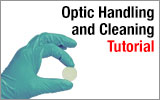
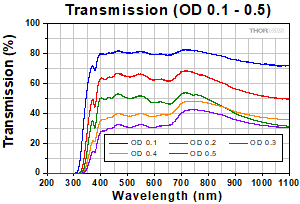
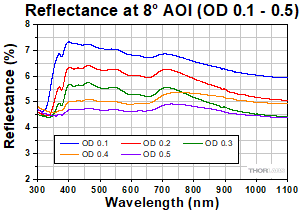
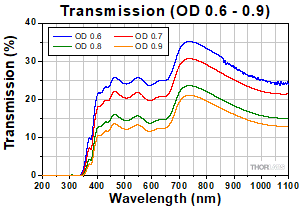
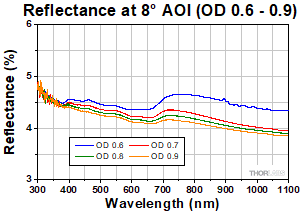
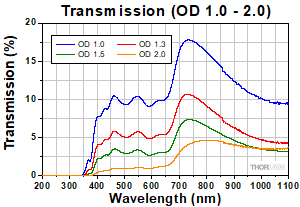
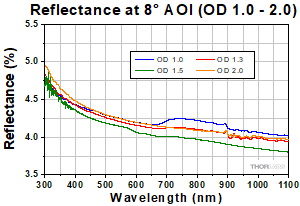
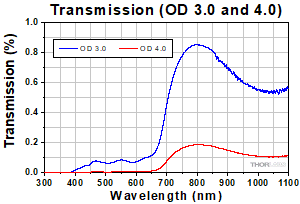
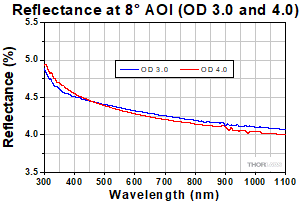
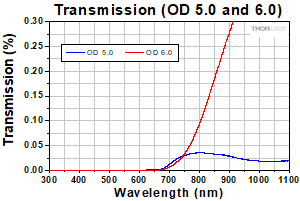
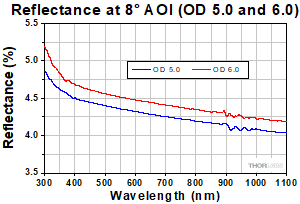
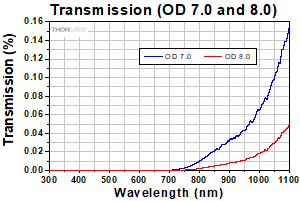
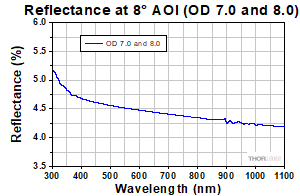

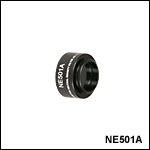
 Zoom
Zoom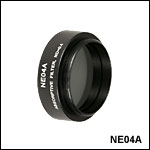
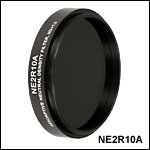

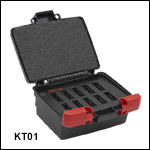
 Mounted Absorptive ND Filters (Schott Glass)
Mounted Absorptive ND Filters (Schott Glass)